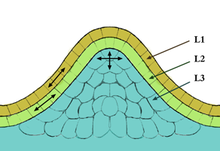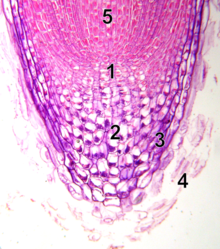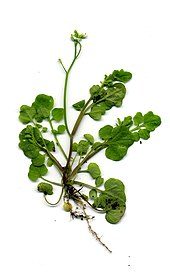Meristem

The meristem is a type of
The term meristem was first used in 1858 by
There are three types of meristematic tissues: apical (at the tips), intercalary or basal (in the middle), and lateral (at the sides also known as cambium). At the meristem summit, there is a small group of slowly dividing cells, which is commonly called the central zone. Cells of this zone have a stem cell function and are essential for meristem maintenance. The proliferation and growth rates at the meristem summit usually differ considerably from those at the periphery.
Primary meristems
Apical meristems give rise to the primary plant body and are responsible for primary growth, or an increase in length or height.[2][3] Apical meristems may differentiate into three kinds of primary meristem:
- Protoderm: lies around the outside of the stem and develops into the epidermis.
- Procambium: lies just inside of the protoderm and develops into primary periderm. In roots, the procambium can also give rise to the pericycle, which produces lateral roots in eudicots.[4]
- Ground meristem: Composed of .
Secondary meristems
After the primary growth, lateral meristems develop as secondary plant growth. This growth adds to the plant in diameter from the established stem but not all plants exhibit secondary growth. There are two types of secondary meristems: the vascular cambium and the cork cambium.
- herbaceousplants).
- Cork cambium, which gives rise to the periderm, which replaces the epidermis.
Apical meristems
Apical Meristems are the completely undifferentiated (indeterminate) meristems in a plant. These differentiate into three kinds of primary meristems. The primary meristems in turn produce the two secondary meristem types. These secondary meristems are also known as lateral meristems as they are involved in lateral growth.

- Central zone
- Peripheral zone
- Medullary (i.e. central) meristem
- Medullary tissue
There are two types of apical meristem tissue: shoot apical meristem (SAM), which gives rise to organs like the leaves and flowers, and root apical meristem (RAM), which provides the meristematic cells for future root growth. SAM and RAM cells divide rapidly and are considered indeterminate, in that they do not possess any defined end status. In that sense, the meristematic cells are frequently compared to the
The apical meristems are layered where the number of layers varies according to plant type. In general the outermost layer is called the tunica while the innermost layers are the corpus. In
Shoot Apical Meristems

Shoot apical meristems are the source of all above-ground organs, such as leaves and flowers. Cells at the shoot apical meristem summit serve as stem cells to the surrounding peripheral region, where they proliferate rapidly and are incorporated into differentiating leaf or flower primordia.
The shoot apical meristem is the site of most of the embryogenesis in flowering plants.[
The shoot apical meristem consists of four distinct cell groups:
- Stem cells
- The immediate daughter cells of the stem cells
- A subjacent organizing center
- Founder cells for organ initiation in surrounding regions
These four distinct zones are maintained by a complex signalling pathway. In
CLV1 has been shown to interact with several cytoplasmic proteins that are most likely involved in downstream signalling. For example, the CLV complex has been found to be associated with Rho/Rac small GTPase-related proteins.[5] These proteins may act as an intermediate between the CLV complex and a mitogen-activated protein kinase (MAPK), which is often involved in signalling cascades.[11] KAPP is a kinase-associated protein phosphatase that has been shown to interact with CLV1.[12] KAPP is thought to act as a negative regulator of CLV1 by dephosphorylating it.[12]
Another important gene in plant meristem maintenance is WUSCHEL (shortened to WUS), which is a target of CLV signaling in addition to positively regulating CLV, thus forming a feedback loop.[13] WUS is expressed in the cells below the stem cells of the meristem and its presence prevents the differentiation of the stem cells.[13] CLV1 acts to promote cellular differentiation by repressing WUS activity outside of the central zone containing the stem cells.[5]
The function of WUS in the shoot apical meristem is linked to the phytohormone cytokinin. Cytokinin activates histidine kinases which then phosphorylate histidine phosphotransfer proteins.[14] Subsequently, the phosphate groups are transferred onto two types of Arabidopsis response regulators (ARRs): Type-B ARRS and Type-A ARRs. Type-B ARRs work as transcription factors to activate genes downstream of cytokinin, including A-ARRs. A-ARRs are similar to B-ARRs in structure; however, A-ARRs do not contain the DNA binding domains that B-ARRs have, and which are required to function as transcription factors.[15] Therefore, A-ARRs do not contribute to the activation of transcription, and by competing for phosphates from phosphotransfer proteins, inhibit B-ARRs function.[16] In the SAM, B-ARRs induce the expression of WUS which induces stem cell identity.[17] WUS then suppresses A-ARRs.[18] As a result, B-ARRs are no longer inhibited, causing sustained cytokinin signaling in the center of the shoot apical meristem. Altogether with CLAVATA signaling, this system works as a negative feedback loop. Cytokinin signaling is positively reinforced by WUS to prevent the inhibition of cytokinin signaling, while WUS promotes its own inhibitor in the form of CLV3, which ultimately keeps WUS and cytokinin signaling in check.[19]
Root apical meristem

- quiescent center
- calyptrogen (live rootcap cells)
- rootcap
- sloughed off dead rootcap cells
- procambium
Unlike the shoot apical meristem, the root apical meristem produces cells in two dimensions. It harbors two pools of
Intercalary meristem
In angiosperms, intercalary (sometimes called basal) meristems occur in
Floral meristem
When plants begin flowering, the shoot apical meristem is transformed into an inflorescence meristem, which goes on to produce the floral meristem, which produces the sepals, petals, stamens, and carpels of the flower.
In contrast to vegetative apical meristems and some efflorescence meristems, floral meristems cannot continue to grow indefinitely. Their growth is limited to the flower with a particular size and form. The transition from shoot meristem to floral meristem requires floral meristem identity genes, that both specify the floral organs and cause the termination of the production of stem cells. AGAMOUS (AG) is a floral homeotic gene required for floral meristem termination and necessary for proper development of the
Through the years, scientists have manipulated floral meristems for economic reasons. An example is the mutant tobacco plant "Maryland Mammoth". In 1936, the department of agriculture of Switzerland performed several scientific tests with this plant. "Maryland Mammoth" is peculiar in that it grows much faster than other tobacco plants.
Apical dominance
Apical dominance is where one meristem prevents or inhibits the growth of other meristems. As a result, the plant will have one clearly defined main trunk. For example, in trees, the tip of the main trunk bears the dominant shoot meristem. Therefore, the tip of the trunk grows rapidly and is not shadowed by branches. If the dominant meristem is cut off, one or more branch tips will assume dominance. The branch will start growing faster and the new growth will be vertical. Over the years, the branch may begin to look more and more like an extension of the main trunk. Often several branches will exhibit this behavior after the removal of apical meristem, leading to a bushy growth.
The mechanism of apical dominance is based on auxins, types of plant growth regulators. These are produced in the apical meristem and transported towards the roots in the cambium. If apical dominance is complete, they prevent any branches from forming as long as the apical meristem is active. If the dominance is incomplete, side branches will develop.[citation needed]
Recent investigations into apical dominance and the control of branching have revealed a new plant hormone family termed
Diversity in meristem architectures
The SAM contains a population of
Role of the KNOX-family genes


The KNOX family has also been implicated in
Indeterminate growth of meristems
Though each plant grows according to a certain set of rules, each new root and shoot meristem can go on growing for as long as it is alive. In many plants, meristematic growth is potentially indeterminate, making the overall shape of the plant not determinate in advance. This is the primary growth. Primary growth leads to lengthening of the plant body and organ formation. All plant organs arise ultimately from cell divisions in the apical meristems, followed by cell expansion and differentiation. Primary growth gives rise to the apical part of many plants.
The growth of nitrogen-fixing root nodules on legume plants such as soybean and pea is either determinate or indeterminate. Thus, soybean (or bean and Lotus japonicus) produce determinate nodules (spherical), with a branched vascular system surrounding the central infected zone. Often, Rhizobium-infected cells have only small vacuoles. In contrast, nodules on pea, clovers, and Medicago truncatula are indeterminate, to maintain (at least for some time) an active meristem that yields new cells for Rhizobium infection. Thus zones of maturity exist in the nodule. Infected cells usually possess a large vacuole. The plant vascular system is branched and peripheral.
Cloning
Under appropriate conditions, each shoot meristem can develop into a complete, new plant or clone. Such new plants can be grown from shoot cuttings that contain an apical meristem. Root apical meristems are not readily cloned, however. This cloning is called asexual reproduction or vegetative reproduction and is widely practiced in horticulture to mass-produce plants of a desirable genotype. This process known as mericloning, has been shown to reduce or eliminate viruses present in the parent plant in multiple species of plants.[30][31]
Propagating through cuttings is another form of vegetative propagation that initiates root or shoot production from secondary meristematic cambial cells. This explains why basal 'wounding' of shoot-borne cuttings often aids root formation.[32]
Induced meristems
Meristems may also be induced in the roots of legumes such as soybean, Lotus japonicus, pea, and Medicago truncatula after infection with soil bacteria commonly called Rhizobia.[citation needed] Cells of the inner or outer cortex in the so-called "window of nodulation" just behind the developing root tip are induced to divide. The critical signal substance is the lipo-oligosaccharide Nod factor, decorated with side groups to allow specificity of interaction. The Nod factor receptor proteins NFR1 and NFR5 were cloned from several legumes including Lotus japonicus, Medicago truncatula and soybean (Glycine max). Regulation of nodule meristems utilizes long-distance regulation known as the autoregulation of nodulation (AON). This process involves a leaf-vascular tissue located LRR receptor kinases (LjHAR1, GmNARK and MtSUNN), CLE peptide signalling, and KAPP interaction, similar to that seen in the CLV1,2,3 system. LjKLAVIER also exhibits a nodule regulation phenotype though it is not yet known how this relates to the other AON receptor kinases.
Lateral Meristems
Lateral meristems, the form of secondary plant growth, add growth to the plants in their diameter. This is primarily observed in perennial dicots that survive from year to year. There are two types of lateral meristems: vascular cambium and cork cambium.
In vascular cambium, the primary phloem and xylem are produced by the apical meristem. After this initial development, secondary phloem and xylem are produced by the lateral meristem. The two are connected through a thin layer of parenchymal cells which are differentiated into the fascicular cambium. The fascicular cambium divides to create the new secondary phloem and xylem. Following this the cortical parenchyma between vascular cylinders differentiates interfascicular cambium. This process repeats for indeterminate growth.[33]
Cork cambium creates a protective covering around the outside of a plant. This occurs after the secondary xylem and phloem has expanded already. Cortical parenchymal cells differentiate into cork cambium near the epidermis which lays down new cells called phelloderm and cork cells. These cork cells are impermeable to water and gases because of a substance called suberin that coats them.[34]
See also
References
- ISBN 9789812704085
- ^ Baucher, Marie; AlmJaziri, Mondher; Vandeputte, Olivier. "From primary to secondary growth: origin and development of the vascular system". academic.oup.com. Retrieved 2023-03-18.
- PMID 28708264.
- ^ a b Evert, Ray, and Susan Eichhorn. Raven Biology of Plants. New York: W. H. Freeman and Company, 2013. Print.
- ^ PMID 12221985.
- S2CID 15360609.
- PMID 10521522.
- PMID 10082464.
- ^ PMID 11457943.
- ^ PMID 18171480.)
{{cite journal}}: CS1 maint: multiple names: authors list (link - PMID 10740268.
- ^ PMID 9701578.
- ^ S2CID 18995751.
- S2CID 4418158.
- S2CID 2401801.
- PMID 14973166.
- PMID 8565856.
- PMID 27624829.
- PMID 19717465.
- ISBN 978-0470016176.
- PMID 20705179.
- S2CID 34386672.
- ^ a b c Lohmann, J. U. et al. (2001) A Molecular Link between Stem Cell Regulation and Floral Patterning in Arabidopsis Cell 105: 793-803
- ^ "Branching out: new class of plant hormones inhibits branch formation". Nature. 455 (7210). 2008-09-11. Retrieved 2009-04-30.
- PMID 11641280.
- ^ PMID 17056620.
- S2CID 14469173.
- S2CID 5775104.
- S2CID 45069635.
- . Retrieved 24 January 2023.
- PMID 8324570.
- .
- PMID 26078728.
- ^ "Plant Development II: Primary and Secondary Growth | Organismal Biology". organismalbio.biosci.gatech.edu. Retrieved 2024-04-08.
Sources
- Plant Anatomy Laboratory from University of Texas; the lab of JD Mauseth. Micrographs of plant cells and tissues, with explanatory text.
- Schoof, Heiko; Lenhard, M; Haecker, A; Mayer, KF; Jürgens, G; Laux, T (2000). "Arabidopsis shoot meristems is maintained by a regulatory loop between Clavata and Wuschel genes". Cell. 100 (6): 635–644. S2CID 8963007.
- Scofield and Murray (2006). The evolving concept of the meristem. Plant Molecular Biology 60:v–vii.
